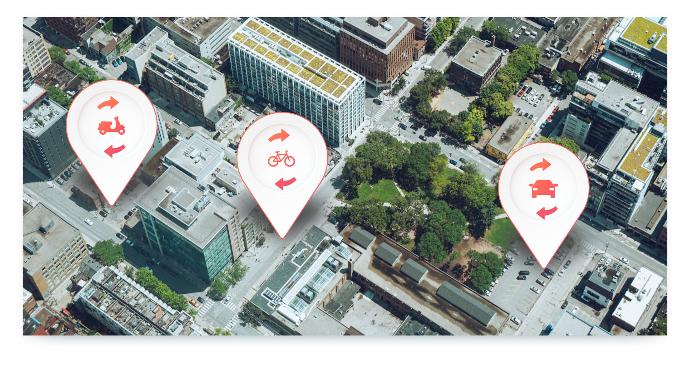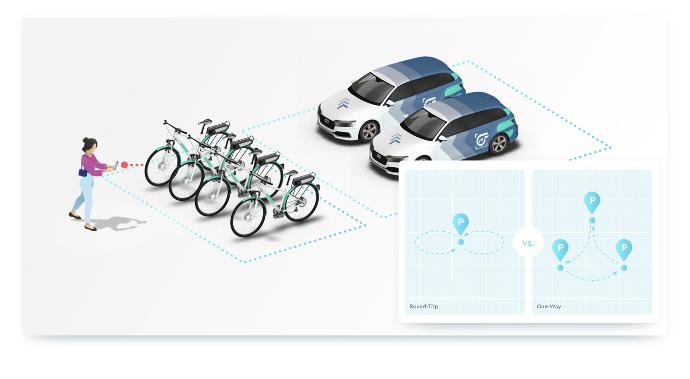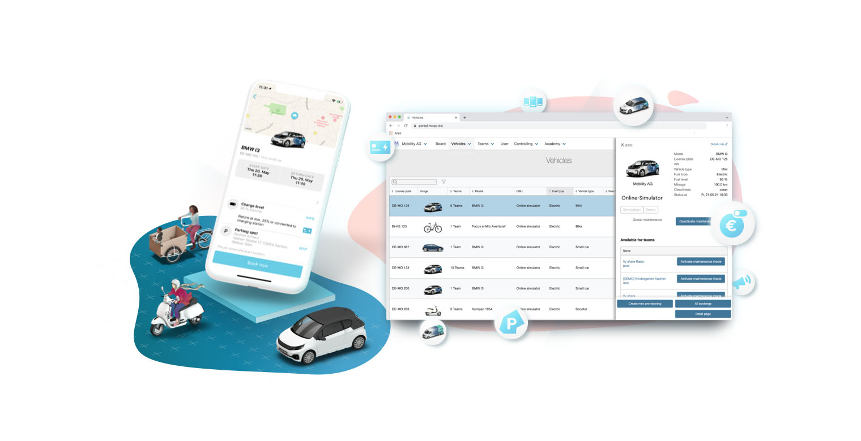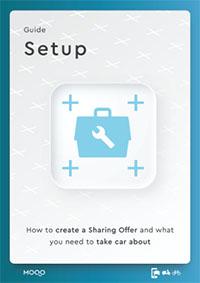Shared mobility is a key driver of the mobility revolution. But to actually achieve this, many more shared mobility providers are needed - especially in rural districts and cities. How to develop your own sharing offer step by step and launch it on the market.
The mobility turnaround requires one thing above all: a move away from motorized individual transport. In other words, from the private car. Instead, a sustainable mobility mix includes local public transport, walking, cycling, cab rides and shared mobility.
Many new providers do not originally come from the mobility industry and first have to get to know the special features of the market and the requirements of their customers. In addition to classic mobility start-ups, transport companies and automotive groups, energy providers, housing associations, universities, local authorities and tourism businesses also want to establish shared mobility as a new business sector.

However, before they can begin implementation, essential questions need to be answered. Why do I want to develop a sharing offer? Who should use my sharing offer? What exactly should the offering look like? Where and how should it be usable? To answer these questions, sharing organizations need a fundamental knowledge of the market and the various options it offers.
The following 7 steps show how an innovative and customer-oriented offer can be created from the initial idea to the launch.

Step 1: Get to Know Market and Target Group
The initial research and analysis is the foundation of subsequent offer planning. The findings help you develop an offer that is tailored to your market and target group.
Which target group you want to address will emerge in the course of this phase. Who might be interested in what you have to offer? Not only socioeconomic and demographic criteria play a role (e.g., age, gender, income, occupation), but also psychographic characteristics such as values, attitudes, and lifestyle.
It is also important to take a close look at the local mobility market. Where are the current pain points? Is it the congested traffic and lack of parking spaces typical for a city? Or the lack of alternatives to owning a car in the countryside? Different initial situations lead to different motivations among (potential) users as to why shared mobility is used.
Scooter sharing in the countryside could be aimed at young people who do not yet have a car driver's license but still want to be individually mobile. Carsharing in the big city can appeal to people who usually travel by bicycle or public transport, but need a car for shopping or trips now and then.
To-Do
Find out which target groups you want to serve.

Step 2: Define Vision and Goals
As in any industry, the most successful companies in Shared Mobility are those that know exactly what they want to achieve and why. In other words, those that have a vision and set goals.
In practice, a hunch about this is usually the trigger why the plan of an own shared mobility offer is tackled at all. This is then usually consolidated in the course of the preceding analysis phase, when local mobility needs are examined. Here, however, it is now a matter of concretizing and recording your vision and your goals. What drives you? What problems do you want to solve?
A vision and concrete goals help to bundle the forces of your team and send them in the same direction. They provide orientation and promote motivation. This applies to both idealistic and economic goals.
To-Do
Determine what you want to achieve with your offer.

Step 3: Develop Business Model
A shared mobility business model consists of various building blocks. These include the choice of vehicle types offered. Should it be pure carsharing? Would you prefer micromobility with e-bikes or scooters? Or vans in front of furniture stores or home improvement centers? A mix of different vehicles can also make sense, depending on the target group(s) and objectives.
The second key component is the decision between free-floating and station-based. With free-floating, users can pick up and park vehicles flexibly in a defined business area. With station-based services, there are fixed stations, i.e. parking areas, for the vehicles. Both round-trip sharing (i.e., the vehicle is returned to the same station where it was picked up) and one-way sharing (i.e., the starting and end stations can be different) are possible.

While free-floating is predominant today, especially in large cities, a station-based service also has its advantages. For example, vehicles can be reserved in advance, making it more reliable for customers to find a vehicle when they need it. Of course, it is important that there is an actual need at the selected stations. It is recommended that the stations be located close to residential areas and that they be connected to transportation hubs such as train stations.
To-Do
Decide on the type and delivery method of your sharing offer.

Step 4: Plan Financing
To be realistic: A service must not only appeal to users and solve problems in the mobility market, but must also be profitable. This is the only way it can last and be truly sustainable. In concrete terms, this means that you need a realistic overview of the costs involved, a calculation of future revenues, and a strategy for financing the project, especially in the initial period.
A large part of the costs are, of course, the purchase or leasing costs of the vehicles. In addition, there are costs for maintenance, repair and cleaning, equipment, refueling and charging costs, and depreciation. Other cost centers are own or external employees, costs for software, IT and telematics units, rent, insurance, taxes, marketing costs, bank charges...
You control the revenue via the rates. Here you can combine kilometer prices, time prices and booking fees. In the end, each trip should not only cover the specifically attributable costs, but also include a contribution margin for general costs.
However, since you need to put money in hand long before the first bookings, you need secured financing. In addition to sufficient equity, loans from the bank, investors or crowdfunding come into question. Public funding can also be an option.
To-Do
Create an overview of costs, revenues and financing options.

Step 5: Compose a Fleet
The fleet is the core of your offering - and should fit the target group. You have already determined the vehicle types as part of the business model. Now it's time to select models and numbers.
Especially in carsharing, the question often arises: electric or combustion engine? There is no universally valid answer here. As a rule, the Bundesverband Carsharing e. V. recommends not operating an all-electric fleet as long as many people are still skeptical about the new technology. Ultimately, however, it once again depends on the company's own target group. Is it open to electromobility? Are there enough charging stations in the region?
In principle, a sharing service works with both conventional and electrically powered vehicles. Another relevant aspect with regard to the choice of model is the question of how brand-affine a target group is. Could a new Tesla be the decisive argument for using carsharing? Or will another (less expensive) model do?
With regard to the size of the fleet, it is better to start small and then grow. You don't have to offer 50 vehicles right from the start, but perhaps 5 is enough at first. You can always scale up afterwards. But in the meantime, you will already have gained experience, have well-rehearsed processes and can avoid certain mistakes.
To-Do
Find the right vehicle models for your offer.

Step 6: Choose the Right Software
What distinguishes shared mobility from classic vehicle rental is, in a certain sense, the degree of digitization. After all, it is only with digital software solutions that enable the operation of a sometimes complex offering and automate processes that it becomes scalable and economical.
On the one hand, you need a portal that you can use to control your service, manage vehicles, bookings and users, perform billing, distribute tasks and view statistics. On the other hand, you need an app that users can use to book, open and close vehicles.

Since the entire customer journey is handled by the system, you depend on its stability, functionality and security. Only a clean and intuitive booking process leads to high user satisfaction. Therefore, it is not advisable for most providers to develop their own software. Instead, it makes more sense (and is faster) to use existing and proven solutions.
To-Do
Find a software package that fits your needs.

Step 7: Design Marketing Measures
In the end, the most important thing is that a shared mobility offering is known to and used by the right people. The key word: marketing.
You need a brand personality that is based on your vision and goals and tells a compelling story. This will appeal to your target audience and set you apart from potential competition. To be recognized, constant branding is crucial.
Also find the right channels to reach your target group: be it via social media, online advertising, print ads or displayed flyers and posters. Cooperations with large companies or municipal institutions also make your brand visible.
In addition, marketing tools such as discount codes or "refer a friend" campaigns help to expand your own reach and attract new customers.
To-Do
Develop a meaningful marketing strategy.

The Key Success Factors Along the Way
Whether an offer is successful or not later depends on many factors. However, it is too easy to pass the responsibility and point to "the location", "the competition" or "the financial starting position". Instead, focus on the success factors that you can actually influence yourself:
Network.
Find partners to help you implement your offer.
Know who you are addressing.
The key is to focus on your target group.
Keep an eye on your numbers.
Regular cost control helps to readjust at any time and to make adjustments in expenses and tariffs.
Stay efficient.
You don't have to do things differently than the competition - you just have to do them better.
Be scalable.
Only with efficient processes can you ensure that a growing range of products and services does not lead to proportionally more work.
Keep a long breath.
Few providers are profitable from the start, so allow yourself a test period of about 2 years.





